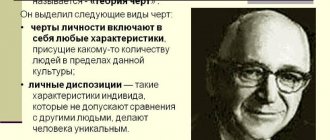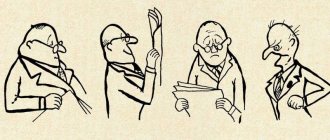Accentuation of character (or accentuation) is an actively used concept in scientific psychology. What is this mysterious phrase and how did it appear in our lives?
The concept of character was introduced by Theophrastus (a friend of Aristotle) - translated as “trait”, “sign”, “imprint”. Accentuation, accent - stress (translated from Latin)
First, it’s worth understanding the concept of character. On scientific resources one can find its definition as a set of personality traits that are stable and determine a person’s behavior, his relationships with others, habits and, as a result, his future life.
Accentuation of character is an excessive strengthening of a certain personality trait that determines the specificity of a person’s response to the events of his life..
Accentuation is on the verge of normality and pathology - if there is excessive pressure or impact on the accentuated feature, it can take on “inflated” forms. However, in psychology, accentuations are not classified as personality pathologies; the difference is that, despite the difficulties of building relationships with others, they are capable of self-control.
Accentuations of Lichko's character
Each person has stable personality characteristics, temperament, demeanor, style of communication with others and reactions to various circumstances. All these traits can be called in one word - character. It is he who gives the individual distinctive properties and makes him an individual.
Not all character traits are positive. Some cause a lot of difficulties in the life of their owner. These features, as a rule, are congenital, and in the process of socialization they can undergo changes. Maybe the subject will be able to suppress them altogether in everyday life. But in a critical situation, negative qualities can manifest themselves very clearly.
Accentuation of character is the excessive expression of its individual properties. This personality trait affects behavior and actions, attitude towards oneself and others. This is an extreme variant of the norm, which is not considered a mental disorder. Among young people, obvious or hidden accentuations are found in 95% of those examined. Growing up, a person smoothes out undesirable features, and the number of accentuations decreases to 50-60%.
Excessive expression of certain characteristics is not always harmful. For example, people with a hysterical type are talented actors, and those with a hyperthymic type are positive, sociable and can find a common language with any person.
Demonstrative type
A characteristic feature of this accentuation is demonstrative behavior , emotional liveliness, and artistry . Such people have a craving for fantasizing , lying and pretense, usually this is not due to the presence of malicious intent, they like to embellish their own personality in the eyes of others. They strive to be the center of attention and love praise and attention . This type of accentuation is characterized by rapid adaptation to new conditions and emotional mobility. They are inconsistent in their actions, one day they will confirm and agree with your point of view, and on the next they will completely sincerely say the opposite opinion.
Hyperthymic and cycloid
The hyperthymic type is characteristic of people who are poor strategists, but brilliant tacticians. They are enterprising, resourceful, active, and easily navigate changing circumstances. Due to this, they can significantly improve their social and professional position and move up the career ladder. But at a certain moment they tend to lose their position due to their inability to calculate certain actions in advance; they often make mistakes in people.
People with the hyperthymic type are sociable, active, enterprising, they are always in a good mood, at least in public. Children are restless, active, often play around and play pranks. Teenagers study unstably and have poor discipline. Because of this, conflicts arise with representatives of the older generation. They always have a lot of superficial hobbies, none of which really interests them. In life, they constantly overestimate their capabilities.
Cycloid accentuation is characteristic of apathetic and irritable people. As children, they constantly want to be left alone and do not like to play with their peers. They take any troubles very hard, and in response to any comments they become very irritated, even if they are the most harmless. Adolescents with cycloid accentuation experience dramatic mood changes.
In adulthood, the sharpest edges are smoothed out, but some can get stuck on their complexes, turning into melancholic and depressed individuals. Often their mood depends on the time of year.
Excitable type
They are characterized by increased impulsiveness , low control of their own desires and inclinations, which are often led. Uncontrollable during violent emotional reactions .
Instinctiveness is characteristic : they do not take into account the voice of reason and sanity, they are subject to momentary desires and desires, without thinking about the consequences.
They often show irritability and intolerance towards their surroundings and cannot tolerate criticism . To people with this accentuation, study and work seem neither fun nor attractive. They usually do not set long-term and difficult-to-achieve goals and live in the present . It is difficult for them to get along in a team due to frequent conflicts. During them, they may show inappropriate emotional reactions, react violently and spend a long time sorting things out.
Sensitive, schizoid and hysterical types
Representatives of the sensitive type are characterized by high sensitivity to any events, both frightening and joyful. Teenagers avoid active and active games and do not like large companies and pranks. They are shy and timid with strangers and give the impression of withdrawn people. At the same time, they become loyal and good comrades for those truly close to them. They do not like to communicate with peers, preferring people much older or younger than themselves. They treat their parents with love, they are afraid to upset them, so they are always obedient.
All this leads to the likelihood of developing an inferiority complex; it is difficult for them to adapt to a new team. They place inflated moral demands on themselves and others. They treat complex activities with reverence and are very responsible.
Adolescents of the schizoid type prefer loneliness to communication with peers, or, in extreme cases, the company of older people. They are not interested in communicating with other people, remaining demonstratively indifferent to it. They often do not understand their experiences and feelings, and do not show sincere sympathy for others. They also hide their own emotions; as a rule, they lack mutual understanding with their peers, which is why they treat them with hostility.
Representatives of the hysterical type love to have all attention paid to them; they are artistic and demonstrative by nature. When someone else is praised in their presence, they strive to occupy an exceptional position, attract everyone’s attention, and influence others as much as possible
They often become organizers of some projects and events. At the same time, their organizational skills are extremely undeveloped; it is difficult for them to gain authority among their peers and become their informal leaders, although they constantly want this.
Dramaturgy of characters - characterological questionnaire of K. Leonhard
- My publications
Typology of character accentuations by K. Leonhard.
Descriptive part of the Leonhard-Smishek questionnaire. Leonhard's characterological questionnaire interpretation The article presents descriptions of the types of character accentuations described by Karl Leonhard: demonstrative type, stuck type, cyclothymic type, excitable type, hyperthymic type, dysthymic type, anxious type, exalted type, emotive type.
Each of us asks the questions: “Who am I, what am I, what can I do, why did I come into this world, what am I capable of?” Since ancient times, people have been looking for answers to these questions, creating certain characterologies and typologies. A person strives to understand himself, to develop his best qualities, as this will allow him to realize himself more fully, to build a model of life that meets his needs and ideals.
For psychological science, the study of individual characteristics of people is almost the main task. In an effort to understand this phenomenon, many scientists have sought approaches to solving this problem. The types of psychological appearances of people, united by common persistent features of mental make-up and behavior, and character types, were identified and described. Many clinical scientists have developed character and temperament typologies to understand and explain the nature of human behavior.
It is known that fate is determined by character. The word “character” is of Greek origin and is translated as “imprint.” Character determines the life stories that a person lives. This is what is inherent in a person by nature and upbringing, what is called “you can’t cut it out with an ax.” But we can, knowing the characteristics of our own character, its weaknesses and strengths, direct its manifestations in the direction we need and in the right way, thereby changing the boring and unloved plot of life.
The famous German psychiatrist and psychologist Karl Leonhard, having worked with people for a long time, developed a typology of accentuated personalities, the presentation of which is the purpose of this article.
Based on the typology of character accentuations developed by Karl Leonhard, G. Šmishek developed a questionnaire to identify character accentuations, which can become an effective working tool for us in the science of self-knowledge.
The theoretical basis of the questionnaire is the concept of “accentuated personalities” by K. Leonhard, who believes that the inherent personality traits can be divided into basic and additional. The main features make up the core, the “core” of the personality. In the case of pronounced expression, the main features become accentuations of character. Accordingly, individuals whose main features are clearly expressed are called “accentuated” by Leonhard.
K. Leongard gave a psychologically subtle, deep and interesting analysis of complex and highly practical cases of accentuations, and described cases of combined accentuations. According to Leonhard, the dynamics of personality accentuations lead both in the direction of psychopathy and in a positive direction, which does not lead to phenomena of social maladaptation. According to K. Leonhard, a person without accentuations is an inexpressive person.
In this regard, it should be noted that accentuation can lead to both personality disorders and be a striking feature of a person, his talent. Leonhard himself greatly valued the presence of accentuated traits in a personality, but as a psychiatrist he understood that the same manifestation can lead to bright manifestations of the personality, become a source of success and intensive development, but can also lead to distortions in behavior, and in neglect to pathological manifestations. Each accented type has its own strong side and shadow side.
It is important to identify and know your accented trait, since we can achieve success only by following our nature. A person cannot suddenly become different, “good,” by getting rid of his weaknesses and shortcomings. It is important to realize that there are no clearly bad and good characters, but each type has its own characteristics and manifestations, and ultimately, behind each accentuation lies the power of great talent, which should help a person reveal and express himself to the maximum possible extent.
Leonhard identified ten pure types and a number of intermediate (mixed) types. The first group is the types related to manifestations of temperament, caused by natural formations. These include: hyperthymic (desire for activity, pursuit of experiences, optimism, focus on success); dysthymic (inhibition, emphasizing ethical aspects, worries and fears, focus on failure); affectively labile (mutual compensation of traits, focus on different standards); anxious (fearfulness, timidity, humility); affectively exalted (inspiration, sublime feelings, elevating emotions to a cult); emotive (kindness, timidity, compassion).
The second group is types determined by social formations: demonstrative (self-confidence, vanity, boasting, lies, flattery, focus on one’s own self as a standard); pedantic (indecisiveness, conscientiousness, hypochondria, fear of self-inconsistency with ideals); stuck (suspiciousness, resentment, vanity, transition from elation to despair); excitable (temper, heaviness, focus on instincts).
Leonhard attributes the traits that determine a person’s individuality to various mental spheres: the sphere of orientation of interests and inclinations, the sphere of feelings and will, the sphere of intellect. The accentuated trait will permeate all these areas.
So, a classic description of the types of character accentuations of K. Leonhard.
Characteristic questionnaire of K. Leonhard - interpretation. Typology of character accentuations by K. Leonhard
1. Demonstrative type
Characterized by an increased ability to repress, demonstrative behavior, liveliness, mobility, and ease of establishing contacts. He is prone to fantasy, deceit and pretense, aimed at embellishing his person, adventurism, artistry, and posing. He is driven by the desire for leadership, the need for recognition, the thirst for constant attention to his person, the thirst for power, praise; the prospect of being undetected weighs him down. He demonstrates high adaptability to people, emotional lability (easy mood swings) in the absence of truly deep feelings, and a tendency to intrigue (with an externally soft manner of communication). There is boundless egocentrism, a thirst for admiration, sympathy, veneration, and surprise. Usually the praise of others in his presence causes him a particularly unpleasant feeling; he cannot stand it. The desire for a company is usually associated with the need to feel like a leader, to occupy an exceptional position. Self-esteem is very far from objectivity. He can irritate with his self-confidence and high claims; he systematically provokes conflicts, but at the same time actively defends himself. Possessing a pathological ability to repress, he can completely forget what he does not want to know about. This unchains him in his lies. Usually he lies with an innocent face, because what he is talking about, at the moment, is true for him; Apparently, he is not internally aware of his lie, or he is aware of it very shallowly, without noticeable remorse. Able to captivate others with his originality of thinking and actions.
These people have a very rich imagination, they easily get used to the role and begin to behave in accordance with their imaginations.
Strengths: self-confidence, artistry, ability to present oneself, high ability to adapt, ability to make contact, tune in to an interlocutor, sensitivity to the needs and actions of others, active social orientation, desire for success and achievement.
Weaknesses: posturing, vanity, exaggeration of one’s own capabilities, arrogance, narcissism, pursuit of image, the strategy of “appearing” rather than “being,” drawing attention to one’s own exclusivity, superficiality.
2. Stuck type
He is characterized by moderate sociability, boringness, a penchant for moralizing, and taciturnity. Often suffers from imaginary injustice towards him. In this regard, he shows wariness and distrust towards people, is sensitive to insults and grief, is vulnerable, suspicious, vindictive, worries about what happened for a long time, and is not able to “easily move on” from insults. He is characterized by arrogance and often initiates conflicts. Arrogance, rigidity of attitudes and views, and highly developed ambition often lead to persistent assertion of his interests, which he defends with particular vigor. He strives to achieve high results in any business he undertakes and shows great persistence in achieving his goals. The main feature is a tendency to affect (love of truth, resentment, jealousy, suspicion), inertia in the manifestation of affects, in thinking, in motor skills.
The stuck personality type is interesting because it equally harbors the possibility of both positive and negative character development. As you know, a person can only achieve respect and authority if he achieves positive results in something, standing out from others. Therefore, everyone who is more ambitious strives to achieve high performance in any type of activity. Sensitivity to blame. Determination, great perseverance. As we see, this type of people persistently pursues their goals and achieves extraordinary success. However, these individuals are very vulnerable and, when faced with obstacles, react with hostility.
Strengths: determination, perseverance, ambition, diligence, sense of duty and responsibility, idealism, fighters for ideas and justice.
Weaknesses: tendency to form overvalued ideas, excessive demands, resentment, resentment, vindictiveness, rigidity, fear of one’s own inadequacy, perfectionism, self-confidence in one’s own rightness, fanaticism, fierce ambition, prejudice, intolerance.
3. Pedantic type
It is characterized by rigidity, inertia of mental processes, heaviness to rise, and long experience of traumatic events. He rarely enters into conflicts, acting as a passive rather than an active party. At the same time, he reacts very strongly to any manifestation of disorder. At work he behaves like a bureaucrat, making many formal demands on others. Punctual, neat, pays special attention to cleanliness and order, scrupulous, conscientious, inclined to strictly follow the plan, unhurried in carrying out actions, diligent, focused on high quality work and special accuracy, prone to frequent self-examinations, doubts about the correctness of the work performed, grumbling, formalism . Willingly cedes leadership to other people.
The pedant looks for patterns, builds classifications and models. Painstakingly and with incredible patience, he will follow the process technology. He strives for order, following the established ritual. It is important for him to maintain traditions; what is established and time-tested is characterized by incredible consistency. However, he lacks decisiveness.
Strengths: accuracy, caution, high reliability, consistency, hard work, ability to plan, combinatorial abilities, attentiveness, observation, self-control.
Weak qualities: suspicion, fear, suspiciousness, constant worry, fear of responsibility, workaholism, addiction to stereotypes, suppression of spontaneity and creative impulses, tightness.
4. Excitable type
Insufficient controllability, weakening of control over drives and impulses are combined in people of this type with the power of physiological drives. He is characterized by increased impulsiveness, instinctiveness, rudeness, tediousness, gloominess, anger, a tendency to rudeness and abuse, to friction and conflicts, in which he himself is an active, provoking party. Irritable, quick-tempered, often changes jobs, and is difficult to get along with in a team. There is low contact in communication, slowness of verbal and non-verbal reactions, heaviness of actions. For him, no work becomes attractive, he works only when necessary, and shows the same reluctance to learn. Indifferent to the future, he lives entirely in the present, wanting to extract a lot of entertainment from it. Increased impulsiveness or the resulting arousal reaction is difficult to suppress and can be dangerous to others. He can be domineering, choosing the weakest for communication.
In the positive development of his qualities, a person is able to direct his persistence and stubbornness in a positive direction, using his fighting qualities for good deeds. He may have a very powerful attitude towards obtaining results, with passion he may strive for power, fame, success, he knows how and loves to take risks.
Strengths: courage, bravery, demonstration of one’s own strength, dynamism, energy, determination, determination and perseverance, pressure, perseverance, ability for long intense activities, experimentation, audacity, desire for active overcoming.
Weak qualities: extreme irritability, aggressiveness, rebellion, cruelty and unceremoniousness, intolerance, destructiveness, uncontrolled emissions of destructive energy, destructive sexuality, insatiability, thirst for pleasure, thrill-seekers.
5. Hyperthymic type
People of this type are distinguished by great mobility, sociability, talkativeness, expressiveness of gestures, facial expressions, pantomimes, excessive independence, a tendency to mischief, and a lack of a sense of distance in relationships with others. They often spontaneously deviate from the original topic of conversation. They make a lot of noise everywhere, love the company of their peers, and strive to boss them around. They almost always have a very good mood, good health, high vitality, often a flourishing appearance, good appetite, healthy sleep, a tendency towards gluttony and other joys of life. These are people with high self-esteem, cheerful, frivolous, superficial and, at the same time, businesslike, inventive, brilliant interlocutors; people who know how to entertain others, energetic, active, proactive. A great desire for independence can be a source of conflict. They are characterized by outbursts of anger and irritation, especially when they encounter strong opposition and fail. They are prone to immoral acts, increased irritability, and projectism. They do not take their responsibilities seriously enough. They find it difficult to endure conditions of strict discipline, monotonous activity, and forced loneliness.
These people readily respond to everything new, they are interested in everything, everything captivates them. In its positive version, hyperteam is an irreplaceable person in a team. With his enthusiasm and optimistic attitude, he is able to infect his comrades and support them in difficult times. It is always fun and interesting to be with such a person, as he is able to carry others along with him. They are decisive in their actions and capable of great efficiency.
Strengths: enthusiasm, optimism, interest in life, energy, spontaneity, action, business acumen, ingenuity, sociability, ability to inspire and encourage others.
Weak qualities: excessive impulsiveness, superficiality, dispersion of forces and interests, inability to focus on the main thing, instability of attention, scatteredness, projectism, arrogance, unreliability.
6. Dysthymic type
People of this type are distinguished by seriousness, even depressed mood, slowness, and weak willpower. They are characterized by a pessimistic attitude towards the future, low self-esteem, as well as low contact, reticence in conversation, even silence. Such people are homebodies, individualists; They usually avoid society and noisy company and lead a secluded lifestyle. They are often gloomy, inhibited, and tend to fixate on the shadow sides of life. They are conscientious, value those who are friends with them and are ready to obey them, have a heightened sense of justice, as well as slow thinking.
Distims are people who tend to constantly work internally on themselves. Dissatisfaction with themselves encourages them to improve themselves and develop their personality. Without meeting approval from their environment, they, as a rule, turn to self-education, the development of new skills and abilities, and the development of unusual abilities. This person may strive to comprehend the transcendental realms and the otherworldly. Lacking high contact and adaptability to the environment, they strive to be self-sufficient. Possible urges to asceticism and seclusion. With positive development, this person is capable of deep comprehension of himself, human nature, and the manifestation of wisdom. He may be preoccupied with finding the meaning of life, the highest justice.
Strengths: reliability, high responsibility, seriousness, conscientiousness, need for self-improvement, wisdom, desire for knowledge, meditativeness, intuition.
Weak qualities: lethargy, passivity, despondency, low self-esteem, self-isolation, feeling of infringement, low tone of mood, soul-searching, self-criticism, extreme indecisiveness, inability to exert volition, fear of the public.
7. Anxious type
People of this type are characterized by low communication, minor mood, timidity, timidity, and lack of self-confidence. Children of the anxious type are often afraid of the dark, animals, and are afraid to be alone. They avoid noisy and lively peers, do not like excessively noisy games, experience a feeling of timidity and shyness, and have a hard time with tests, exams, and inspections. They are often embarrassed to answer in front of the class. They willingly submit to the tutelage of their elders; adult lectures can cause them remorse, guilt, tears, and despair. They early develop a sense of duty, responsibility, and high moral and ethical requirements. They try to disguise the feeling of their own inferiority in self-affirmation through those types of activities where they can reveal their abilities to a greater extent. The touchiness, sensitivity, and shyness characteristic of them since childhood prevent them from getting close to those with whom they want; a particularly weak link is the reaction to the attitude of others towards them. Intolerance to ridicule and suspicion are accompanied by the inability to stand up for oneself, to defend the truth in the face of unfair accusations. They rarely enter into conflicts with others, playing a mainly passive role in them; in conflict situations, they seek support and support. They are friendly, self-critical, and diligent. Due to their defenselessness, they often serve as “scapegoats” and targets for jokes.
Anxious individuals can be very responsible workers, as their demands on themselves are quite high. At the same time, an increased background of anxiety forces them to treat their responsibilities more carefully and diligently, encouraging them to continuous self-improvement and self-development.
Strengths: fidelity to one's obligations, sense of duty, self-demandingness, desire to avoid conflicts.
Weak qualities: self-blame, timidity, shyness, fearfulness, lack of self-confidence, weak initiative, dependence on the environment, susceptibility to doubt and hesitation.
8. Exalted type
A striking feature of this type is the ability to admire, admire, as well as smiling, a feeling of happiness, joy, pleasure. These feelings can often arise in them for a reason that does not cause much excitement in others; they easily become delighted with joyful events and in complete despair - with sad ones. They are characterized by high contact, talkativeness, and amorousness. Such people often argue, but do not lead to open conflicts. In conflict situations, they are both active and passive parties. They are attached to friends and loved ones, altruistic, have a sense of compassion, good taste, and show brightness and sincerity of feelings. They can be alarmists, subject to momentary moods, impulsive, easily move from a state of delight to a state of sadness, and have mental lability.
The main feature of an exalted personality is a violent, exalted reaction. They easily become delighted by joyful events and despair by sad ones. They are distinguished by extreme impressionability about sad events and facts. At the same time, internal impressionability and experience are combined with their vivid external expression. Such individuals tend to react deeply to individual events, but also to depressive or euphoric states in a broad general sense. They fall into inconsolable despair just as easily as they plunge into ecstatic bliss. His feelings and motives bear the imprint of drama. Out of nothing he is capable of making a tragedy, the drama of life. He is inclined to vigorously express his admiration.
Strengths: inspiration, sublimity, poetry, passion, romanticism, sensitivity, receptivity, imagination, the gift of perceiving harmony and beauty, the ability to express complex and deep feelings in forms.
Weaknesses: alarmism, dramatization, longing for what is not here and now, theatrical behavior, idealization/devaluation transitions, patheticism.
9. Emotive type
This type is related to the exalted one, but its manifestations are not so violent. They are characterized by emotionality, sensitivity, anxiety, talkativeness, timidity, and deep reactions in the area of subtle feelings. The most strongly expressed trait is humanity, empathy for other people or animals, responsiveness, kindness, and rejoicing at the successes of others. They are impressionable, tearful, and take any life events more seriously than other people. Teenagers react sharply to scenes from films where someone is in danger; scenes of violence can cause them a strong shock that will not be forgotten for a long time and can disturb their sleep. They rarely enter into conflicts, they carry grievances within themselves and do not “spill out” outside. They are characterized by a heightened sense of duty and diligence. They take care of nature, love to grow plants and care for animals.
The main feature of an emotive personality is high sensitivity and deep reactions in the field of subtle emotions. Characterized by kindness, kindness, sincerity, emotional responsiveness, and highly developed empathy. All these features, as a rule, are clearly visible and constantly manifest themselves in the external reactions of the individual in various situations. A characteristic feature is increased tearfulness (“wet eyes”). This person is focused on areas related to human problems and experiences.
Strengths: empathy for others, sense of duty, ability to experience subtle emotions, active feelings, receptivity, friendliness, desire to help others, altruism, gentleness in communication.
Weak qualities: humility, control, inertia, subordination to the environment, lack of initiative, absent-mindedness.
10. Cyclothymic type
Characterized by alternating hyperthymic and dysthymic states. They are characterized by frequent periodic mood swings, as well as dependence on external events. Joyful events cause pictures of hyperthymia in them: thirst for activity, increased talkativeness, racing ideas; sad ones - depression, slowness of reactions and thinking, their manner of communication with people around them also often changes. In adolescence, two variants of cyclothymic accentuation can be found: typical and labile cycloids. Typical cycloids in childhood usually give the impression of being hyperthymic, but then lethargy and loss of strength appear; what was previously easy now requires exorbitant effort. Previously noisy and lively, they become lethargic homebodies, there is a decrease in appetite, insomnia, or, conversely, drowsiness. They react to comments with irritation, even rudeness and anger, in the depths of their souls, however, at the same time falling into despondency, deep depression, suicidal attempts are not excluded. They study unevenly, make up for any omissions with difficulty, and create in themselves an aversion to studying. In labile cycloids, the phases of mood changes are usually shorter than in typical cycloids. “Bad” days are marked by more bad mood than lethargy. During the period of recovery, the desire to have friends and be in company is expressed. Mood affects self-esteem.
Cyclothyme is characterized by sharp changes from vigorous active activity to despondency and passivity. Because of this, he may appreciate the absence of strict regulations and schedules. For him, the opportunity to live and work in a spontaneous, creative atmosphere, not subject to rigid schedules and guidelines, is beneficial. A comfortable environment is very important for him and can have a positive impact. Potentially this is a very creative person. Loves surprises, avoids routine.
Strengths: mobility, emotionality, responsiveness, mobility.
Weak qualities: instability, unbalance, dependence on one’s own mood, tendency to apathy, irritability, sudden mood swings, from violent activity to complete weakness.
Presented questionnaire developed by G. Smišek
, will allow you to determine the presence or absence of character accentuations.
(5)
Hyperthymic character
Character accentuations according to Leonhard also include the “hyperthymic” type. A hyperthymic person is always inspired. Brilliant ideas and Napoleonic plans are born in his head every five minutes. He loves to tell all his acquaintances about them, and these stories inspire him even more, but he rarely fulfills his promises for one simple reason: firstly, a hyperthymic person, like Julius Caesar, loves to do 10 things at the same time, and secondly, it’s fast for him His activities become boring, and he again looks for a new niche for activity. Nevertheless, it is interesting to be with such a person; due to his broad interests in life, he is able to carry on a conversation on any topic and give worthwhile advice completely free of charge or offer an interesting way out of a crisis situation.
Accentuations of character and degree of their expression
The psychiatrist noted two degrees of manifestation of a person’s accentuated characteristic traits - obvious and hidden.
An obvious degree is a state when the accentuated character traits of a person have excellent expression and can manifest themselves throughout life. Moreover, such traits are mostly well compensated even in the absence of mental trauma. In adolescents, maladjustment is sometimes observed.
But with a latent degree, they most often appear after one or another mental trauma or during one or another stressful situation. Accented traits mostly do not disrupt adaptation, but sometimes short-term maladjustment is observed.
Andrey Lichko
In Russian psychology, the typology of character according to A. E. Lichko is very popular. This is a domestic psychiatrist, Doctor of Medical Sciences. He was born in the Leningrad region in 1926. Graduate of the Leningrad Pavlov Medical Institute. His research interests included the treatment and diagnosis of mental disorders in adolescence.
He created his own typology of personalities, relying on the work of Leonhard and his compatriot Pyotr Borisovich Gannushkin. His monograph “Psychopathy and Character Accentuations in Adolescents,” which was published in 1977, was popular. In fact, it still remains a reference book for domestic psychologists and psychiatrists.
He paid great attention to the popularization of science. He was the executive secretary on the editorial board of the Journal of Evolutionary Physiology and Biochemistry, edited the Review of Psychiatry and Medical Psychology named after
V. M. Bekhterev."
German psychiatrist classification
Leonhard determined types of character in psychology by assessing a person’s communication style with the people around him. At the same time, he developed and presented independent types of characters.
- Hyperthymic type. Such people are distinguished by their talkativeness, extreme contact, expressiveness of facial expressions and gestures. A person may regularly deviate from the original topic of conversation in communication; he may constantly have occasional conflicts with people around him due to the fact that he is too frivolous about family and work responsibilities. As a rule, such people themselves become initiators of conflicts. At the same time, they have many positive features that attract partners for communication. This is a thirst for activity, energy, initiative, optimism. Repulsive traits include a tendency to immoral acts, frivolity, and increased irritability.
- Dysthymic type. The person is taciturn, uncommunicative, pessimistic about the surrounding reality, and leads the most secluded lifestyle. At the same time, he values his friends highly and is ready to obey them.
- Cycloid type. He is characterized by regular mood swings, which changes the way he communicates with people around him.
- Excitable type. Such a person is characterized by low contact in communication, slow nonverbal and verbal reactions. Such people are prone to abuse and rudeness, are gloomy and boring, and constantly provoke conflicts.
- Stuck type. These are moderately sociable people, prone to moralizing, and very taciturn. In any business they strive to achieve maximum performance and place increased demands on themselves. Vulnerable and touchy, sensitive to social justice.
- Pedantic type. They practically do not enter into conflicts and generally behave passively. At work they make many claims and demands on others, and behave like bureaucrats.
- Anxious type. People from this group are characterized by timidity and low communication skills. They are predominantly in a depressed mood and feel insecure. They rarely enter into conflicts with others and play an extremely passive role in them.
- Emotive type. Such people prefer to communicate exclusively among a select few. They carry grievances deep within themselves. People around them are attracted by compassion, kindness, and have a heightened sense of duty. At the same time, they are very tearful and sensitive.
- Demonstrative type. These people easily establish contacts with complete strangers, love to be praised, and strive for leadership and power. Demonstrating high adaptability, they are prone to intrigue. At the same time, they irritate those around them with their own self-confidence, boasting, and hypocrisy. They are attracted by their exceptional artistry, courtesy, extraordinary actions and thinking, and are able to captivate others with some idea.
- Exalted type. Amorous and talkative people. They argue constantly, but rarely lead to conflict. They are attentive to friends, altruistic, ready to sympathize and show sincerity. They are repelled by susceptibility to momentary moods and alarmism.
- Extroverted type. These are contact people with a lot of friends and acquaintances. They always have many acquaintances and close friends, they are open to communication and any information. They attract others with their diligence and willingness to listen to another person. Many do not like him because of their frivolity, passion for entertainment, rash actions, and regularly participate in the spread of rumors.
- Introverted type. These are closed people, divorced from reality. They love to be alone. They have strong beliefs about life around them and strict principles. At the same time, they are ready to persistently defend their ideals, even if they are fundamentally wrong and stubborn.
It is worth emphasizing that this classification applies mainly to adults.
Classification according to Leonard
The concept of “character accentuation” was first introduced by the German scientist Karl Leonhard, who subsequently proposed the first classification of accentuations in the middle of the last century.
Leonhard's typology includes 10 accentuations, which were subsequently divided into 3 groups; their difference is that they relate to different manifestations of personality:
- temperament
- character
- personal level
Each of these groups includes several types of accentuations:
- Temperament accentuations:
Leonhard’s classification of temperament accentuations includes 6 types:
Table 1: Leonhard classification
| Hyperthymic | The hyperthymic type is sociable, loves to be among people, and easily makes new contacts. He has pronounced gestures, lively facial expressions, and loud speech. Labile, prone to mood swings, therefore often does not fulfill his promises. Optimistic, active, proactive. Strives for something new, needs vivid experiences, varied professional activities. |
| Dysthymic | Taciturn, stays away from noisy companies. Overly serious, unsmiling, distrustful. He is critical of himself, which is why such people often suffer from low self-esteem. Pessimistic. Pedantic. The dysthymic personality is reliable in close relationships, morality is not an empty word. If they make promises, they strive to fulfill them. |
| Affectively labile (cycloid) | People have moods that change several times a day. Periods of active activity are replaced by complete powerlessness. The affect-labile type is a person of “extremes”; for him there is only black and white. The manner of relationships with others depends on the mood - behavioral transformations are frequent - yesterday he was affectionate and kind to you, but today you cause him irritation. |
| Affectively exalted | They are emotional, and the emotions they experience manifest themselves clearly and sincerely. Impressionable, amorous, quickly inspired. These people are creative, among them there are many poets, artists, and actors. They can be difficult to interact with, as they tend to exaggerate and make mountains out of molehills. In a difficult situation they are prone to panic. |
| Anxious | The anxious type of accentuation is not self-confident, difficult to make contact, and shy. Shy, which clearly manifests itself in childhood - children with such accentuation are afraid of the dark, loneliness, sharp sounds, and strangers. He is suspicious, often sees danger where there is none, and experiences failures for a long time. Examples of positive aspects of the anxious type are responsibility, diligence, and goodwill. |
| Emotive | The accentuated personality of the emotive type is similar to the exalted type in the depth of the emotions experienced - they are sensitive and impressionable. Their main difference is that the emotive type finds it difficult to express emotions; he accumulates them in himself for a long time, which leads to hysteria and tears. They are sympathetic, compassionate, and willingly help helpless people and animals. Any cruelty can plunge them into the abyss of depression and grief for a long time. |
- Description of character accentuations:
| Demonstrative | Artistic, lively, emotional. They strive to impress others, but do not disdain pretense and even outright lies. The demonstrative type believes in what he says. Even if he realizes his lies, there is no reason to feel remorse, since he tends to repress any kind of unpleasant memories from his memory. They love to be the center of attention, are influenced by flattery, and it is important for them to take into account his merits. They are fickle and rarely keep their word. |
| Pedantic | Accented personalities of the pedantic type are slow and carefully think about it before making a decision. They strive for orderly professional activities, are diligent and see things through to the end. Any type of change is perceived painfully, transformations for new tasks are difficult to achieve. They do not have conflicts and calmly give up leading positions in a professional environment. |
| Stuck | The stuck type retains emotional experiences in memory for a long time, which characterizes behavior and perception of life; they seem to be “stuck” in a certain state. Most often it is wounded pride. They are vindictive, suspicious, not trusting. In personal relationships they are jealous and demanding. They are ambitious and persistent in achieving their goals, which is why accentuated personalities of the stuck type are successful in professional life. |
| Excitable | The excitable type, in moments of emotional arousal, has difficulty controlling desires, is prone to conflicts, and is aggressive. Reasonableness retreats, unable to analyze the consequences of its behavior. Accented personalities of the excitable type live in the present and do not know how to build long-term relationships. |
- Description of personal level accentuations:
The classification of accentuations at the personal level is familiar to everyone. The concepts of extrovert and introvert often used in everyday life are described in pronounced forms in the table below
| Extroverted | Open, sociable, loves to be among people, does not tolerate loneliness. Non-conflict. Planning your activities is difficult, frivolous, demonstrative. |
| Introverted | The concept of “introverted person” means that he is silent, reluctant to communicate, and prefers loneliness. Represses emotions, withdrawn. Stubborn, principled. Socialization is difficult. |
Conformal, psychasthenic and paranoid types
Minors of the conformist type do not have their own opinions, they are not critical of themselves, and lack initiative. They are very easy to subordinate to some authority or group of people. The life attitude of most of them in any situation can be characterized by the words “be like everyone else.” At the same time, they are very conservative and prone to moralizing. To protect their interests, they are even ready to commit very unseemly acts, for which they find explanation and justification.
Adolescents of the psychasthenic type are prone to deep introspection, reflection, and assessment of the behavior of the people around them. In terms of their intellectual development, they are ahead of their peers; their indecision is combined with peremptory views and judgments, and self-confidence. When they need attentiveness and discretion, they are often prone to impulsive actions. With age, representatives of the psychasthenic type experience little change. This often ends in drug or alcohol use. In relationships, they are petty and despotic, this prevents them from normal communication with people around them.
It is interesting that the paranoid type is not always included in Lichko’s classification. The fact is that its main manifestations appear only after 30, or even 40 years. In adolescence and especially childhood, its representatives are usually classified as schizoid or epileptoid accentuation. In adulthood, inflated self-esteem and the idea of one’s own exclusivity begin to come to the fore. They differ from delusional ideas only in that others perceive them as quite real, albeit unreasonably exaggerated.
Anxious type
They are subject to anxiety and fears for various reasons. Unsure of thoughts and decisions. They sense danger around them and are worried for no particular reason. For a long time they tend to experience failures, are afraid of making a mistake and choosing the wrong decision, and are indecisive. During a dispute, they can hardly defend their positions; it is easier for them to silently agree with someone else’s point of view.
They are distinguished by commitment and diligence , they are characterized by a high level of responsibility and self-criticism .
Very often they cannot withstand external conditions and feel exhausted and cannot withstand stress factors. They feel insecure being the center of attention when speaking in front of an audience. They do not start conflicts and try to avoid them.
Unstable, emotionally labile and epileptoid types
Teenagers with unstable personality types constantly gravitate towards idleness and entertainment. They have no life goals and interests in life; they care little about the future. In most cases, those around them characterize them as people going with the flow.
Children with an emotionally labile personality type are characterized by strong and regular mood swings, and their behavior is unpredictable for others. It is noteworthy that any little things can become the reason for such mood changes. For example, an unfriendly phrase or a sidelong glance. When they are in a bad mood, adolescents with an emotionally labile personality type feel the need for support from loved ones. They feel well how others treat them.
At an early age, representatives of the epileptoid type are very tearful. But when they grow up, they themselves begin to offend the little ones, preferring to mock those who are not able to fight back. They are characterized by cruelty, power and pride. In the society of other children, they strive not just to become leaders, but real rulers. In groups that take control, they establish the most rigid, sometimes even autocratic, orders. They are able to please management and often occupy influential positions due to this.
Emotive type
They are distinguished by increased sensuality , they are characterized by deep sensory experiences and increased emotionality. Unlike exalted individuals, they do not express their feelings externally, but accumulate them. They experience deep feelings from various life experiences , both positive and negative. They avoid conflict situations and are not prone to showdowns. They try to contain within themselves , but they do not always succeed, they are whiny and sensitive . They are characterized by responsiveness and empathy , not only for close people, but also for fictional characters in literature and films. The rudeness of others provokes stress and can lead to emotional turmoil.
Personality accentuation theories
The first theory of character accentuations was developed by Karl Leogard, it became incredibly useful and most closely matched the definition of a person’s character. But its use was limited by the fact that only adults could answer the questions. Since a child or teenager, due to lack of the necessary experience, cannot answer them, it is extremely difficult to determine their accentuation.
The domestic psychiatrist Andrei Lichko began to solve the problem. He was able to modify the Leogard test to determine the character of a person regardless of his age. In addition, Lichko somewhat reworked the characteristics of the types of accentuations, renamed some of them and introduced several new types.
Lichko believed that it is very important to study character accentuations in adolescents, since they are formed in childhood and at this age they manifest themselves especially clearly. The specialist expanded the characteristics of certain accentuations due to certain manifestations in childhood and adolescence, as well as how they change with age
The psychiatrist devoted such works to this as:
- "Teenage drug addiction";
- "Adolescent Psychiatry";
- “Psychopathy and character accentuations in adolescents.”
The role of accentuations in personality structure
In the personal structure, accentuations occupy a leading role and largely determine the quality of life of an individual.
It is worth considering that accentuation is not a diagnosis! In a psychologically mature person, it manifests itself as a feature, which can be a clue in choosing a place of study, profession, or hobby.
If accentuation takes on pronounced forms (this depends on many factors - upbringing, environment, stress, illness), then it is necessary to use drug treatment. In some cases, certain types of character accentuation can lead to the formation of neuroses and psychosomatic diseases (for example, a labile type often suffers from infectious diseases), and in extreme cases, such a person can be dangerous.
Accentuation of personality character in dynamics
Psychological science has not yet thoroughly studied the problems associated with the development or dynamics of character accentuations. Andrey Lichko made the most significant contribution to the study of this problem and noted the following phenomena in the development of accentuations:
- they are formed and sharpened to one degree or another during puberty, then they are smoothed out or compensated, obvious accentuations can change and become hidden;
- against the background of hidden accentuations, the traits of a particular type of character are revealed under traumatic circumstances;
- with one or another accentuation, certain disorders or disturbances may appear in the form of neuroses, acute effective reactions or deviant behavior;
- one or another type of them can be transformed under the influence of the environment or mechanisms that were laid down by the human constitution;
- acquired psychopathy is formed.
Personality accentuation
The author of the typology of character accentuations was the first to propose using this term in official scientific literature. With it he replaced the previously existing concept of personality accentuation. The main motive for this was that a person’s personal characteristics cannot be generalized by this concept, since they are much broader and also include worldview, education, perception characteristics, and reaction to external stimuli.
In psychology, character accentuation is temporary changes in an individual’s character that can disappear or radically change during the development and growth of the child. The fact is that character is an external reflection of the type of our nervous system and becomes a specific characteristic of the characteristics of human behavior. The changes that occur in a teenager can last a lifetime or develop into psychopathy. In this case, the path of accentuation is determined by its severity, type and social environment.
As a result, this definition was finally entrenched in psychology. Accentuation of character is a concept that has determined the development of characterology for many years.
At the same time, Lichko, like Leonhard, considered accentuation to be only one of the variants of character deformation, in which its individual traits acquire additional expression. All this increases the sensitivity of the individual to some types of influences, making it difficult to adapt in other cases. As a result, a person develops the ability to adapt at a fairly high level. At the same time, accentuated individuals cope much more successfully with certain types of influences that do not touch the place of least resistance.
Lichko imagined accentuation itself as a kind of borderline state between psychopathy and the norm. In this regard, the classification itself is largely based on the typology of psychopathy that existed at that time. In total, Soviet scientists identified eleven varieties.
Personality diagnostic methods
Leonhard considered observation and conversation to be the most reliable diagnostic methods. During a personal conversation, the scientist should not study verbal information coming from the patient, but focus on his facial expressions and changes in voice intonation. Studying the patient’s behavior at work, in a relaxed home environment, and in communication with other people, according to Leonhard, provides comprehensive information about the characteristics of his personality.
However, it is not always possible to carefully monitor patients even in a hospital setting. In this case, working with G. Šmishek’s questionnaire will come to the rescue.
The text of the questionnaire, the key for processing answers, a detailed description of individual scales and combinations can be found in the book by Yu.V. Kortneva “Diagnostics of a current problem. Leonhard-Smishek technique."
As a person grows up and his personality develops, bright accentuated features smooth out. By adapting to the demands of the social environment, the individual learns to control his natural temperament. As a rule, Leonhard’s character typology is used when working with teenagers whose character has not yet been completely established.










